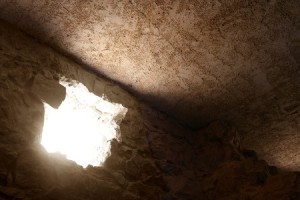The Imprints of His Glory

“I have never met the man I could despair of after discerning what lies in me apart from the grace of God.” (My Utmost for His Highest, June 17th)
Before venturing onto the main highway of the Romans Road of Recovery, we should start our journey by looking at chapter one of Romans and what it says about general revelation, the certainty of God and how it can be applied to addiction. Since belief in Jesus Christ is optional for Twelve Step spirituality, there will be a divergence between the Romans Road and the path of recovery. Yet for an extended part of their journey, Christians along the Romans Road and sojourners along the path of recovery travel in the same direction. The theological explanation for how this is possible is found in Romans 1:20: “For his invisible attributes, namely, his eternal power and divine nature, have been clearly perceived, ever since the creation of the world, in the things that have been made. So they are without excuse.” God has made it possible for all people to have some general knowledge of who He is and what He requires of us to live life—including how to live a sober life.
Romans 1:20 sets this ‘general revelation’ of God within an oxymoron: the invisible attributes of God are clearly perceived in the created order. Commenting on this verse, John Murray said: “God has left the imprints of his glory upon his handiwork.” No one who truly looks at the created order around them can deny the reality of God. The A.A. Big Book, Alcoholics Anonymous, seems to echo this thought: “He was as much a fact as we were. We found the Great Reality deep down within us.” It is in this sense, and this sense only that the path of recovery embodied in the Twelve Steps and the fellowship of self-help groups exists. From a biblical perspective, it is the path to a life aligned with the general revelation of God in the created universe. It provides the way out of the active enslavement for all human beings to drugs and alcohol.
“The Way Out” was originally proposed as the title for the first edition of the Big Book. A search of the Library of Congress showed 25 previously published books titled “The Way Out,” so Alcoholics Anonymous was chosen instead.
Discovering your place in the natural order is a common theme in many non-Christian philosophies and religions. And this idea exists within the recovery literature. Bill Wilson wrote in the “We Agnostics” chapter of the Big Book: “As soon as we admitted the possible existence of a Creative Intelligence, a Spirit of the Universe, underlying the totality of things, we began to be possessed of a new sense of power and direction.” Within Came to Believe, a collection of the diversity of opinions on God as we understood Him, “I believe that the A.A. program is simply the will of God being put to practical, everyday use.” And from the AA Grapevine, the international journal of Alcoholics Anonymous, “I like to think that putting myself in harmony with what seems to be the spirit of the universe is in actuality ‘turning my will and my life over to the care of God as I understand Him.’”
The Introduction to the “Blue Book” of Narcotics Anonymous, a fellowship for drug addicts adapted from Alcoholics Anonymous, states that: “We believe that as a fellowship, we have been guided by a Greater Consciousness, and are grateful for the direction that has enabled us to build upon a proven program of recovery.” In dedicating their book, the writers of the Blue Book said:
God grant us knowledge that we may write according to Your Divine precepts. Instill in us a sense of Your purpose. Make us servants of Your will and grant us a bond of selflessness, that this may truly be your work, not ours–in order that no addict, anywhere need die from the horrors of addiction.
As humans we straddle the border between health and sickness, good and evil, happiness and sadness. We are always trying to gain harmony in life; to preserve beauty and to find order again after balance has been disturbed. All these beliefs have similarities to Stoic philosophy, which was popular during the time when Paul wrote the book of Romans.
Stoicism was founded in the third century BC and remained popular though 529 AD. More than just a philosophical system, it was a way of life. The theologian Paul Tillich said it was “the only real alternative to Christianity in the Western world.” Stoic philosophers said that happiness did not come from the accrual of goods or success, but from virtue. Echoing Twelve Step recovery, they emphasized self-control as the path out of destructive emotions. This self-control was established and maintained through meditation, training, and self-vigilance.
David Davidson said that in meditation the Stoics would visualize their futures. They would imagine the worst possible outcomes as present sufferings—not as distant, unlikely events. “They sought to realize that even the worst misfortunes can be survived and are not worth fearing.” In their training they practiced various physical disciplines from sexual abstinence and vigorous exercise to the avoidance of tempting foods. Their self-vigilance meant they monitored their thoughts and emotions, “seeking to avoid lust, greed, and ambition in favor of reason.” This contemplation, discipline and vigilance have similarities to both Twelve Step recovery and Christian thought.
Stoics applied the imagery of head and body to God and the universe respectively. The universe was the body, and God’s logos or reason was the mind or head that directed it. Stoic ‘salvation’ was then to seek to align your will with the inherent Reason or Logos of the universe. A person was happy when he did not want things to be other than the way they were. He was to strive to know the system of nature and then cultivate an acceptance of it. He was to search for and discover his place within the natural order; and then consciously seek out the things in life that suited his place in that order. It was best to see this life of service as the ‘natural’ life, a life aligned with the logos of the universe.
Although a Christian prayer a written by Reinhold Neibhur, The Serenity Prayer seems to capture this Stoic alignment with logos of the universe. Not surprisingly, the Serenity Prayer holds a special place in A.A. history and Twelve Step Recovery.
The correspondence noted here between Christianity, Stocism and Twelve Step recovery is a product of the general revelation spoken of in Romans 1:20. “God has left the imprints of his glory upon his handiwork.” Part of that handiwork lies within the system of meditation, self-vigilance and training embodied in the Twelve Steps as a way out of the thralldom of active addiction.
For Christians, there is a biblical concern in how we understand general revelation. The theologian G. C. Berkouwer cautioned that while Romans 1 was “good material” for the confession of general revelation, we must be careful of how we apply it. The knowledge of general revelation should never be isolated from the prevailing theme of Romans 1—the wrath of God. Berkouwer said: “The history of theology parades before us numerous attempts to isolate it from the context.” Perhaps the greatest objection of some Christians with Twelve Step recovery lies at this point. If by applying the general revelation of the Twelve Steps, an individual is able to stop the unmanageability in his or her life because of drug or alcohol abuse, they may be aligned with the Logos of the universe in a broad sense, but they will not have reckoned with the wrath of God for their unmanageable, ungodly behavior. They may be sober, but they are not saved from the just spiritual consequences of their unrighteousness.
If you’re interested, more articles from this series can be found under the link for “The Romans Road of Recovery.” “A Common Spiritual Path” (01) and “The Romans Road of Recovery” (02) will introduce this series of articles. If you began by reading one that came from the middle or the end of the series, try reading them before reading others. Follow the numerical listing of the articles (i.e., 01, 02, etc.), if you want to read them in the order they were originally intended. This article is “03,” the third one. Enjoy.










